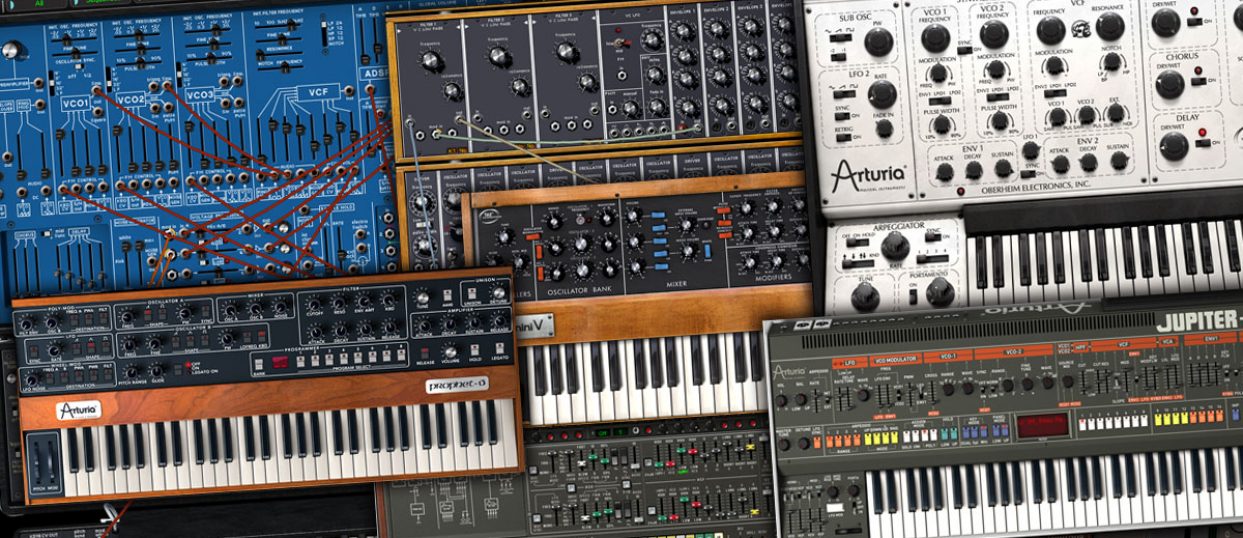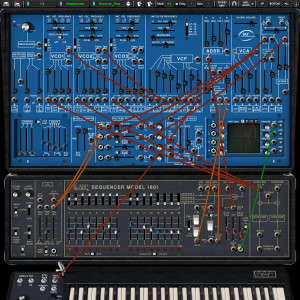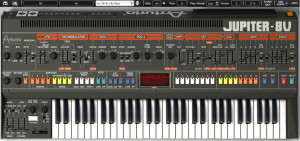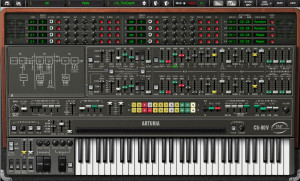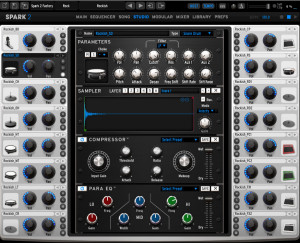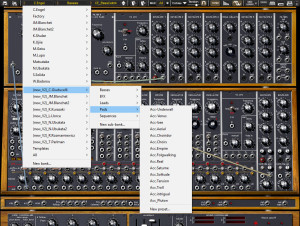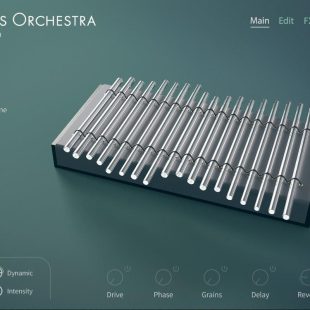Arturia V Collection 4
The trials and tribulations of a 21st Century synthesizer nut couldn’t be more different to those of her 20th Century counterpart. The first difference is the cost. Early synthesizers were well beyond the price range of even serious musicians, and would often be rented for just an afternoon in the studio. Laying down the readies for a new synthesizer was such a rare event that the one or two pieces of gear a band possessed could define their whole sound, or even set the parameters of an entire genre.
Words by Karl Stevens
Fast forward a few decades and the situation is precisely the reverse. It’s remarkable how cheaply and quickly one can accumulate soft synths and sample libraries these days, and, for many of us, the problem is not limited access to great sounds, but having more virtual gear than we know what to do with or being overwhelmed by the plethora of instruments at our disposal and unable to decide which is the right sound for the job. And given that each of those instruments may contain hundreds (if not thousands) of presets, and each of these presets can be manipulated in manifold ways, today’s sonic explorers can easily find themselves adrift on an ocean of sounds without dry land in anywhere sight.
Enter Arturia’s V Collection 4, which, with a foot in both centuries, can hopefully be used to avoid some of the pitfalls of modern synthesis while making the most of its many advantages. The package consists of 13 virtual instruments, with a focus on bringing to contemporary users top-quality emulations of some of the most definitive synths of the 60s, 70s, and 80s. There are two Moogs (a Minimoog and a Modular Moog), two Oberheims (an SEM and a Matrix-12), two Prophets (the Prophet 5 and the Prophet VS in one box), two ARPs (the 2600 and their Solina string machine), the Roland Jupiter 8, the Yamaha CS80, as well as a formidable drum machine, a Wurlitzer electric piano, a Vox transistor organ, and an additional ‘Analogue Lab’ generic interface that allows one to play and manipulate an epic library of 6000 analogue synth sounds derived from those already listed.
True to its era, it packs a phenomenal amount of bang for the buck, at around $400 – less than what an afternoon in the studio with some of these instruments would have cost back in the day. Also true to its era, it presents the user with an astonishing array of choices; at times, I felt I could spend the rest of my musical life coming fully to grips with all the possibilities of just a single one of these instruments. Part of the beauty of having them all in one package, though, is that we don’t need to agonize over getting every sound possible from a single synth, but can draw on each instrument for its most appealing features or most distinctive sounds, cherry-picking from among a synthesizer collection that would have had DEVO weeping with envy beneath their energy domes.
A case in point is the emulation of the Modular Moog, developed in collaboration with the synth’s original designer, the venerable Dr. Robert Moog himself. This fully patchable super synth is extremely powerful, but correspondingly difficult to master, with row upon row of oscillators, filter banks, and envelope controllers, each with patchable inputs. The graphic interface faithfully represents leads dangling out of them willy-nilly (the visual tension of the latter can be adjusted, and they conveniently wriggle out of one’s way to allow access to the controls beneath them, although this feature can be disabled), and, as with the real thing, modules can be changed out and replaced with others. The possibilities are endless. As with the real thing too, if one is willing to take the time, beautiful and highly original sounds can be created, even if getting there can sometimes result in howling obscenities that leave one’s ears ringing and the neighbours preparing for an alien invasion. Thankfully, those of us with time constraints can take as our starting point the great collection of Modular V presets available, where much of the hard graft has already been done for us.
Cherry picking in this way, if I had to choose from among the Modular V’s multiverse of potential noises, it’s the basses, pads, and sequenced sounds that really shine and to which I know I shall return. With only a handful of midi controller knobs assigned, these are easily manipulable and sound rich, fat, and…well, analogue in the extreme. They sound so great by themselves, in fact, that it almost seems a shame to add other instruments to them, a problem that has to be one of the best one can face in the studio.
While on the subject of knobs, it is no secret that they are a big part of the appeal of analogue synthesizers, and are notably absent from most laptops and computers, so to really get to grips with these analogue beauties knob twiddlers will have to assign midi controllers to the various virtual knobs the V Collection has on offer. The good news is that the midi learn function is easy, effective, and once done is remembered whenever your instruments are pulled up within the relevant session (and can be recalled in any subsequent sessions). Multiple configurations can also be saved, in case you have multiple controllers or different preferences for live performance or in the studio. With the plasticity that these analogue synthesizers possess, it’s well worth taking the time to assign as many controls as you have to the knobs of your choice in order to get the most out of these machines. It’s great to give the eyes a rest in this way, even if I did find myself wishing I had more hands!
A step in a slightly more user-friendly direction from the Modular V, and, historically speaking, a step towards a more familiar, hard-wired style of synthesis, is provided by the ARP2600, the gigantic suitcase-shaped slab of technology that created, amongst other things, the voice of our beloved RD2D.
While the sounds are perhaps not quite as rich as those of the Modular Moog, the ease with which the sequencer can be programmed generates very pleasing results with a minimum of fuss. Again there are a great many presets for the synth ready to go (and as with many of the V Collection, still more downloadable from Arturia’s website). There are in fact so many presets that, should navigation become a challenge, a graphic ‘sound map’ that clusters sounds together or spreads them apart and categorises them by shape and colour, is just a click away.
Even simpler still is the delightful grandchild of the Modular Moog, the Minimoog that changed everything due to its tiny size and massive sound when it was released in 1970 (it can be heard all over the Kraftwerk ‘Autobahn’ album). Like the Modular V, it has great sounds, again with the rich, fat tone that the company’s instruments have become famous for. Due to the modest size of the original, the graphic interface is wonderfully easy to use, especially when compared with that of the Modular Moog, and by opening the hood one can access a motion recorder, a nice modulatable vocal filter, arpeggiator, modulation matrix, and effects (delay and chorus). It’s also great to be able to work with classics like the Minimoog but expand their original capabilities, changing it, for example, from monophonic to polyphonic at the push of a button, and, like the ARP2600 V, one can again open a sound map to help navigate the presets with ease.
The Jupiter 8 emulation is exactly what it claims to be, a very faithful replica of the classic Roland keyboard that helped define 80’s pop, from the relentless arpeggiating line in Duran Duran’s ‘Hungry Like the Wolf’ to the big synth blasts that kick Michael Jackson’s ‘Thriller’ into gear. As a big fan of this particular keyboard, I was pleased to discover how faithful the V Collection version is to the original in both sound and feel when working with it. The layout of the original synth lends itself well to the size of the Arturia graphic user interface (GUI) as well, something which, unfortunately, is less true of the CS80 to which I will now turn.
The size of the Arturia V Collection graphic interfaces has already been noted by commentators as a bit of a problem. On purpose-built interfaces like the Spark 2 drum machine and the Analogue Lab this obviously isn’t a consideration, nor does any difficulty arise when working with the smaller synths like the Minimoog, the Oberheim SEM, the Prophets, or the Jupiter 8. When approaching monsters such as the CS80 or the Modular V, however, things can get a bit more fiddly.
As is often the case with Yamahas, the CS80 is a large creature, with a distinctive depth to its sound that was made celebrated use of by Vangelis all over his wonderful ‘Blade Runner’ soundtrack. To my ears, it’s the pads and leads that are the most special features of this synthesizer, all of which can be tweaked to your heart’s content, but the sheer number of faders is likely to leave all but the most sophisticated midi controller coming up short. Indeed, at times I felt that the only truly adequate controller for a CS80 would have to BE a CS80. Forced, for this reason, to engage to a large extent with the GUI, its limited size can become frustrating, especially once the optional modulation panel, for instance, is opened up. I found that even on a large screen it was difficult to read the labels for all of the faders so serious manipulation of the presets can oblige the user to have her nose pressed to the screen, which, after a while, can feel less like making music and more like supervising an ant farm. With this in mind, Arturia would do well to allow users to increase the size of the GUI.
Switching to the CS80 from other synths also managed, on occasion, to crash the Protools 11 system on the MacBook Pro I was using, but to be fair it managed the transition perfectly smoothly as often as not. One wonders, though, if this hints at stability issues in this particular synth.
New to the V Collection 4 is the Oberheim Matrix-12, a very formidable machine that sports that at once brittle yet dark Oberheim sound that is a distinctive feature of bands like Killing Joke among many others. When it comes to Oberheims, my personal preference is for the OB-X series, but the Matrix-12 shares enough of the important features with these that all but a X-series purest should be relatively content. For example, Oberheim has always created extremely musical filters, and the Matrix-12 V has succeeded in capturing this musicality very well. They are a joy to play, and the ease with which different waveforms can be combined and layered up in this synth also yields some very pleasing results. There is also the option to create powerful multis and program chains so that if one should want to really mine the Matrix-12 on a single piece, or play it live as though it were the real thing, there is a great deal of scope to do so. Two layers of additional effects can also be added to lend one’s sounds a bit of extra finish.
A really nice discovery within the V Collection 4 bundle is another Oberheim, this time the SEM synthesizer expander module that was Oberheim’s first official analogue synth. Its size lends itself very well to Arturia’s GUI, and it yields results so quickly and easily that one scarcely needs fuss with controllers or presets to feel like one is well on the path to making good music. Its arpeggiator sounds especially flattering, and were I forced to choose only one of the V Collection 4, this, I think, would be it. Again, if one had to rely on only one synthesizer in a practice room or composing situation, this could be ideal for that as well, as so often what one wants is not infinitesimal control but great, musical sounds fast.
The final two synths in the collection are Sequential Circuits’ Prophet 5 and Prophet VS (the first and last synthesizers the company released), which, in the V Collection 4, can be used either separately or both on top of one another to create a sort of super hybrid Prophet ‘5 VS’ (when switching between the 5 and the VS, the roof of the former opens up to disgorge the latter which can be alarming at first but soon becomes barely noticeable). I have always thought Prophets especially good for their searing lead sounds, and in that department, Arturia’s version certainly doesn’t disappoint. While the sound of both Prophets played simultaneously is a bit intense for my taste, the Prophet VS is an extremely powerful machine in its own right and particularly cool effects can be achieved by using its joystick to mix between its four oscillators, even if it did leave me wishing for a less one-dimensional midi controller.
The V Collection 5 also comes with Arturia’s Spark 2 drum machine and drum sequencer, fully loaded with a solid selection of drum sounds, including some decent retro drum machine samples which are a nice accompaniment to the synths in the bundle. It is designed to favour Arturia’s Spark Creative and LE controllers, but, like so many drum machines, the sequencing style uses highlighted 16th notes, so the absence of something to physically hit shouldn’t pose too much of a hindrance. The sequencer is formidable, and, with the potential to incorporate one’s own samples, add effects, edit, and mix the resulting drums, there’s no reason for an electronic musician to feel constrained by this drum machine, even if, after the avalanche of great synthesizers, nothing about it had me particularly jumping for joy. Every drum machine, to my way of thinking, is as much of a distinct instrument as every synthesizer, so the Spark 2’s generic, albeit powerful, approach to drums paled when contrasted with Arturia’s fantastically authentic approach to analogue synthesizers.
Somewhere between the synths and the non-synths in the package, sits the Solina V string machine, originally manufactured by ARP. String machines were, in some ways, just primitive pad-based synths in terms of sound, and in terms of use somewhere between a synthesizer and an organ. Users of Native Instruments Komplete will already have a few in their arsenal via the Retro Machines MK2 set, but I found myself very pleasantly surprised by Arturia’s Solina V. It just sounds really good, and, while the adjustments that can be made on the front panel are quite limited (switching, for instance, between the rather optimistically labelled ‘viola’, ‘violin’, ‘trumpet’, ‘horn’, and ‘humania’ voices), they are also extremely musical. The bottom octave adds an additional bass voice to beef things out, the volume and tone of which can be adjusted, and under the hood, one can adjust effects (chorus or phaser and analogue or digital delay), tweak the bass sound and the filters of the upper resonator, adjust aftertouch and velocity effects, and fool with the rather pretty sounding LFO. While most string machines, to me, have at best a charming cheesiness, I was pleased to find this one possessed of some real pathos.
Other non-synthesizers included in the package are the Wurlitzer V, and the Vox Continental V organ which, like their synthesizing cousins, have been put together with a keyboardist’s passion for vintage instruments.
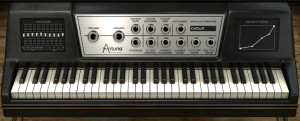 On the face of it, the Wurlitzer V is just a very nicely sampled virtual Wurlitzer electric piano, but do not be deceived! Clicking on the cover of the piano opens a 10-band graphic eq, adjustable velocity curve graph, and a panel where harmonic variation, mechanical noises, and pickup placement among other parameters can all be adjusted in detail.
On the face of it, the Wurlitzer V is just a very nicely sampled virtual Wurlitzer electric piano, but do not be deceived! Clicking on the cover of the piano opens a 10-band graphic eq, adjustable velocity curve graph, and a panel where harmonic variation, mechanical noises, and pickup placement among other parameters can all be adjusted in detail.
I found the pickup placement and the hammer/note-off noise controls particularly helpful for getting an authentic sound. A further click on the FX button reveals a pedal board with a selection of simple stompboxes that can be daisy-chained in various sequences of up to five to produce all sorts of interesting results. At the end of this signal path sits an independent reverb unit and a final choice of adjustable outputs – DI, a nice stereo Leslie cabinet, and an array of amps with different micing configurations. If this much choice sounds daunting, here too there are a large number of presets to choose from, all searchable by style. The best way to think of this instrument, I think, is as an extremely versatile and powerful Wurlitzer set-up. As such, while the flexibility to manipulate the Wurlitzer sound is vast, its limitations are set by the Wurlitzer electric piano itself, so that, try as you might, you won’t get it to sound like a Rhodes or a Yamaha electric piano. As an enormous fan of the Rhodes and Fender Rhodes pianos, I found myself a little hemmed in by the totally authentic Wurlitzerishness of the Wurlitzer V. It is, in short, exactly what it says it is…you may have a lot of wigs, but your face you’re stuck with.
The Vox Continental V is a two manual and one low octave pedal (so effectively three keyboard) version of the 1960’s transistor organ with the distinctive red lid and inverted black and white keyboard, as famously used by The Animals across their output (imagining ‘House Of The Rising Sun’ should give you the idea). Like the original, it sounds great and is fun to play, but possesses a sort of cheesy, sticky, Spongebob Squarepants sound rather than the growling, long-haired purr of the Hammond B3 tonewheel organs. If, like me, you’re a fan of transistor organs and are after less of a Deep Purple/Steppenwolf sound and more of a B52s/Question Mark and The Mysterians sound, then it’s the one for you. Under the lid you can adjust the vibrato and reverb styles and machine noise, and, should you want to give yourself a headache and the rest of the band a heart attack, tweak the tuning of the individual transistors for each note to make, for example, all your B flats flatter and all your Cs painfully sharp. As silly as this may sound, it’s very much in keeping with the functioning of the original organ and so lends authenticity to the tone as well as some nice eccentricity to the playing results. The organ comes with a large number of presets ranging from the straight-laced to the positively extraterrestrial, and, like the Wurlitzer V, it can be routed through stomp boxes of various sorts (albeit only one at a time), and output directly, through a Leslie, or through a small variety of guitar amps with a few different mic choices and positions. Interesting results can also be achieved by switching the organ’s ‘engine’ from the ‘Vox’ circuit to the ‘Jennings’ circuit, the tonal difference reflecting the Vox organ’s designer Tom Jennings’ harsher ‘J’-series organs that he made after being laid off from Vox in 1967. Finally, should you be so inclined you can also change the colour from red to a modest dark grey for formal occasions.
Finally, the Analogue Lab allows one to draw upon 6000 of the presets from the instruments above and manipulate them in various selectable ways (although each starts with a useful set of controls already assigned to the knobs). It sports a very playable interface that allows quick editing of most musical parameters, and is a great option for live work or if, with a client or bandmate sitting over one’s shoulder, one has to come up with a lot of different options rapidly and with minimal fuss. It is worth bearing in mind, though, that the pre-assignment of the knobs, while certainly a helpful feature, will mean that what was your filter resonance on one sound can suddenly become your LFO speed on another so that it pays to look before you twiddle. They can be reassigned at will, though, so there’s no cause for complaint on that account.
All told, I think this is a great collection of superb analogue synthesizer emulations. For the price, it is simply amazing value.
If you are someone with a small collection of sounds looking to ‘gear up’ for some electronic music making with a vintage flavour, I think it would be a brilliant investment. If you are lucky enough to already have access to a large library of sounds, I think the sound quality of these synths, together with the musicality of working with recreations of the original instruments’ panels and workflows, goes a long way towards cutting through creative vertigo that can result from confronting a gigantic modern soft synth with thousands of presets and sound sculpting options and nothing but your taste to guide you. Each vintage synth in the V Collection 4, that is to say, comes with its own strengths and horizons that engender a sort of map of creative possibilities that one can happily orienteer within. A larger, or adjustable, GUI, a more stable CS80, and perhaps an approach with the drum machine more akin to that of the synths -in which one is working more within their original parameters- would be my only suggestions for improvement. Oh, and, at the risk of being greedy, the inclusion of an OB-X, an EPD Wasp, and a Roland Juno 106! The Arturia V Collection 4, though, gives its user PLENTY to be getting along with.
Full details and free demo on Arturia.com
Karl Steven – karlsteven.com

